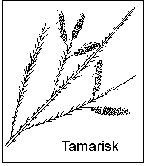Tamarisk is a tree. Tamarisk is also called saltcedar. There are 54 species of tamarisk.
- botanical information
- origin
- history
- astrological correspondences
- magick correspondences and uses
- ancient myths and beliefs
- Goddesses and deities
botanical information:
Botanical name: Tamarix spp.
Common name: saltcedar, tamarisk
Use the botanical name when ordering seeds (bulbs, etc.) or when looking up information in the library. Common names vary by nation, culture, and region, and sometimes the same common name is applied to different plants.

Tamarisk grows as a woody shrub or small tree in areas where water is at or near the surface. Tamarisk is distinguished by its feathery, needle-like leaves and numerous small, pink flowers at the ends of the branches.
Up to half a million tiny wind-dispersed seeds can be produced per plant. Saltcedar (tamarisk) seeds are short-lived (less than two months in the summer), have no dormancy requirements, and germinate in less than 24 hours.
origin:
Origin: North Africa, Mediterranean, Middle East. Imported into the United States in the 1850s as an ornamental and for erosion control.
Tamarisk is an invasive plant and has quickly spread into natural wetlands throughout the Southwest United States, displacing native trees such as cottonwood, willow, and mesquite. Tamarisk usually outcompetes native plants for water. A single large tamarisk can transpire up to 300 gallons of water per day, severely limiting water to native plants and sometimes even drying up a water source.
Tamarisk can grow on salty soil because it has the ability to eliminate excess salt from the tips of its leaves. As the leaves are shed, the salinity of the soil increases, further reducing the ability of native plants to compete.
From a wildlife point of view, tamarisk has little nutritional value (its leaves, twigs, and seeds are extremely low in nutrients) and is usually detrimental to native animals. A study of the tamarisk invasion of the lower Colorado River showed that tamarisk stands supported less than 1% of the winter bird life that would be supported by a native plant stand.
Tamarisk is extremely difficult to eradicate, resprouting readily after cutting or burning. For more information see the National Park Service article the tamarisk invasion.
history:
History: Tamarisk trees commonly lined ancient Egyptian temple gardens.
astrological correspondences:
Astrological planet: Saturn ![]()
magickal correspondences and uses:
Saturn spells: Tamarisk (as an herb) may be used in as an ingredient or substitute for magick spells and formulas related to Saturn matters (endings, exorcism, longevity, protection, purification, and vision). Be careful about substitutions for preparations that will be ingested or come in contact with the skin. These substitutions do not apply to medical uses. See the article on Saturn for a list of herbal substitutes for tamarisk.
Magickal substitutions: Rosemary usually may be safely substituted for any herb in magick spells and rituals. Roses may safely be substituted for any flower.
ancient myths and beliefs:
The ancient Egyptians believed that the tamarisk tree was used by Set to create the trap for Osiris (Asar).
deities associated with tamarisk:
Some herbs may be poisonious under some conditions. Exercise appropriate care.
Wild gathering: Avoid wild gathering. Some plants are endangered species. Some plants can be toxic just by touch. Even experts can make deadly misidentifications of wild plants. Please grow your own herbs in your own goddess garden.

















